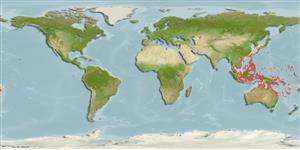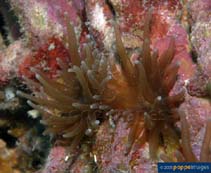Tubastraea diaphana (Dana, 1846)
Black cup coral| Native range | All suitable habitat | Point map | Year 2050 |

|
| This map was computer-generated and has not yet been reviewed. |
| Tubastraea diaphana AquaMaps Data sources: GBIF OBIS |
Classification / Names Common names | Synonyms | CoL | ITIS | WoRMS
Hexacorallia | Scleractinia | Dendrophylliidae
Environment: milieu / climate zone / depth range / distribution range Ecology
Reef-associated; depth range 8 - 54 m (Ref. 120542). Tropical
Distribution Countries | FAO areas | Ecosystems | Occurrences | Introductions
Pacific Ocean.
Length at first maturity / Size / Weight / Age
Maturity: Lm ? range ? - ? cm
Short description Morphology
Life cycle and mating behavior Maturity | Reproduction | Spawning | Eggs | Fecundity | Larvae
Main reference
References | Coordinator | Collaborators
Brook, F.J. 1999 The coastal scleractinian coral fauna of the Kermadec Islands, southwestern Pacific Ocean. Journal of the Royal Society of New Zealand, 29:4, 435-460. (Ref. 88997)
IUCN Red List Status
(Ref. 130435: Version 2025-1)
CITES status (Ref. 108899)
CMS (Ref. 116361)
Threat to humans
Human uses
| FishSource |
Tools
More information
Max. ages / sizes
Length-weight rel.
Length-length rel.
Length-frequencies
Mass conversion
Abundance
Internet sources
BHL | BOLD Systems | CISTI | DiscoverLife | FAO(Publication : search) | Fishipedia | GenBank (genome, nucleotide) | GloBI | Gomexsi | Google Books | Google Scholar | Google | PubMed | Tree of Life | Wikipedia (Go, Search) | Zoological Record



